► The 981 was no longer the 911-lite
► NA, flat-six power for less cash
► What you need to know before you buy
The mention of depreciation-proof Porsches might conjure up motorsport-derived 911s advertised for six-figure sums, but there are plenty of tempting options for less cash. Take the last-generation Cayman, known internally as the 981.
It’s yours from the mid £20ks and likely to only ever flat-line or increase in value. That specialists RPM Technik describe it as dependable and relatively affordable to run and maintain only increases the want factor.
981 Cayman: a new benchmark
The 981 Cayman was – and remains – a benchmark car, and when it arrived in 2012 came closer than ever to stepping on a 911’s toes. The slightly dumpy design of earlier models was replaced by a sleeker, lower look that ratcheted up the desirability; it resulted from the combination of doors that were no longer shared with the 911, a longer wheelbase, wider tracks and lower overall height.
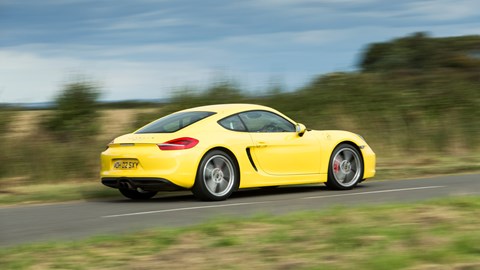
There were also big gains in equipment, space and refinement, and, most importantly, this new Cayman was even better to drive, with a more supple and playful chassis. Key to that appeal was the flat-six engine, which gave up a little in performance versus a 911 but barely anything in its response, soundtrack and feelgood factor. It seemed almost jarringly exotic considering the £40k price Porsche asked when new.
Then Stuttgart slotted a 911 Carrera S engine into the GT4 and, finally, allowed a 911-beating Cayman off the leash. Arguably that’s the pinnacle of Porsche’s Cayman development, and in some ways things went backwards with the arrival of the 982 model in 2016, marketed as the 718 Cayman. Essentially a comprehensive update, with tangible improvements to the super-sharp chassis, it also introduced a four-cylinder engine.
The new turbocharged unit’s significant increases in power,torque and efficiency couldn’t compensate for the loss of the high-revving flat six, its chainsaw soundtrack and the tingly emotion of revving it out to 7500rpm. It’s why buyers pine for the previous model. That high demand has kept prices at a healthy level, but there are enough cars around to stop them going crazy.
‘The six-cylinder 981s have almost stopped depreciating, as buyers have not warmed to the four-cylinder turbo 718s yet,’ says Greig Daly of RPM Technik. ‘I don’t see this changing any time soon either.’
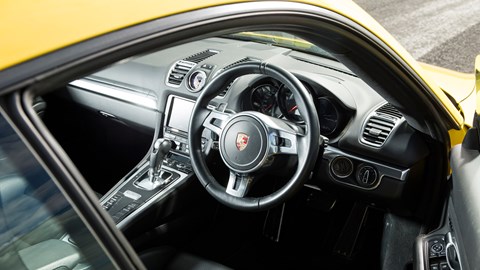
Which model 981 Cayman to go for?
Two basic flavours are available. The entry-level model is fitted with a 2.7-litre flat six with 271bhp and 214lb ft. While it’s a little flat below 4500rpm, it’s by no means a poor relation to faster versions, still plenty quick enough, and soul-stirring when you wring it out on a country road – which, really, is the whole point. If you aim for a high-miler that’s light on options you should be able to find one from around £26,000. Pay a little more and you’ll get lower miles; we found a car on 37k miles at a main dealer with 24 months’ warranty for £31k.
‘Early base 2.7 manual cars are a very good buy: low-cost Porsche ownership without the worry of big bills ruining your summer holiday plans,’ says Nick Cole of the Cayman Owners’ Club. ‘It’s the “I want to sleep at night” Porsche.’
The Cayman S makes for a highly tempting upgrade. It leapfrogs ahead with a 3.4-litre six – the same as its predecessor, and a slightly detuned version of the 911 Carrera’s, with 310bhp and 273lb ft. You also get 19-inch alloys, part-leather interior and bi-xenon headlights. Prices typically start around £30k.
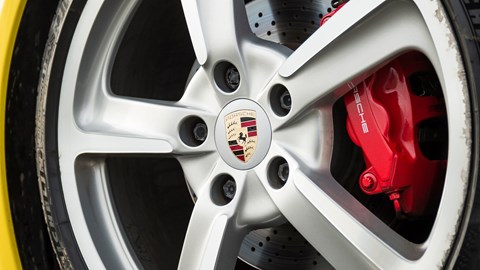
Cole describes the 981 as ‘definitely the most spec-sensitive used Cayman.’ Key options include 20-inch alloys and PASM dampers which, when combined, top off the gorgeous looks while preserving ride quality. You’ll find plenty of cars with both upgrades. Less common is the Porsche Torque Vectoring option, which includes a limited-slip differential – desirable, but not essential given the Cayman’s high grip levels and relatively modest torque, says Cole.
Other options include vented seats, dynamic headlights, 18-way adjustable seats, keyless entry and sat-nav – inessential, given the quality of today’s phone apps.
Manual or auto ‘box?
The biggest dilemma centres around the manual or dual-clutch automatic gearbox, the latter adding over £2k to the sticker when new. Both are satisfying, and the PDK certainly has a greater breadth of ability. It combines the ease-of-use of an auto in traffic with super-incisive shifts that actually enhance the crispness of the powertrain and make keeping it in that sweet spot at the top of the rev range even easier.
Cole reminds us that these cars were sometimes afflicted with Porsche’s crazy rocker buttons on the steering wheel, which were quickly dropped. ‘OEM paddles and a new steering wheel can be retrofitted by a respected specialist or Porsche main dealer, though, so bear that in mind if an otherwise perfect car appears.’ Daly adds: ‘If the car is PDK, then having Sport Chrono is a plus as this will, amongst other things, allow you to change the shift speed on the gearbox.’
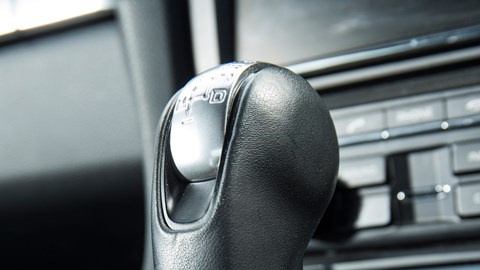
However, we’d guess that those hankering after one of the last great naturally aspirated motors will prefer to pair it with a manual. The six-speeder’s beautifully precise shift quality and perfectly weighted and placed pedals reward that choice. Ultimately, says Daly, there’s no wrong decision, despite the fierce debate between advocates of the different transmissions. ‘The market is good for all 981s, so long as the service history is with either a respected specialist or Porsche.’
What about running costs?
Services are every two years or 20,000 miles, along with a brake fluid swap, and alternate between minor and major. RPM uses Porsche genuine parts, and charges from £438 for a minor service all in, and £795 for a major, which includes brake fluid and plugs. Daly adds a caveat: ‘As the cars start to age, we suggest an annual oil change primarily to ensure the car is being checked by a professional, but also to keep the oil in peak condition.’
Reliability is good. Daly at RPM: ‘The earliest 981s are on a 2012. We’ve had a lot of them through the showroom and workshop, and typically it’s just the usual consumables. We have had a few with leaking PASM dampers – it’s uncommon, an easy spot on a ramp, and can be sorted quickly for £1400 all in.
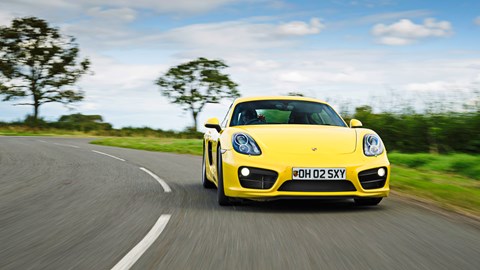
‘We’ve also seen cars where the PSM [stability control] light is on and the brake lights are also on – it’s caused by the bushes on the actual pedal binding and stopping the pedal from fully returning. It is a simple fix if you have the specific tool required, but if left can cause the brakes to overheat and require replacement. Otherwise buy from a business with experience of the 981 and you won’t get into trouble.’
And at the top end of the Cayman tree?
For those with more cash, the Cayman GTS makes a tempting proposition. Not only does it increase power from the 3.4 flat-six to 335bhp, it also bundles key desirable options including adaptive dampers (or no-cost sports suspension, lower by 20mm but giving a lumpier ride), the Sport Chrono package, sports exhaust and dynamic bi-xenon headlights.
The GTS cost £55k new in 2015, yet cars with 10k-30k miles are still advertised for £50k-£60k today. They’re great cars with a lovely spec, but we actually found the standard car more playful on its slightly softer suspension.
The ultimate 981 is the 911-bothering Cayman GT4 with its 3.8-litre six and 380bhp, yours for low £70ks to almost £100k. But then we’re getting away from our original premise, and as a do-it-all sports car on a budget, and a future classic that’s likely to hold its value or appreciate, you can’t really go wrong with a Cayman or Cayman S.
Things to look out for:
- Earlier cars suffer corrosion on brake parts, particularly caliper mounting bolts.
- Get a diagnostics check to see if the DME (engine management) mileage corresponds with dash clock; also examine fault codes, and check for over-revving.
- Look for front radiator damage from debris through the bumper grilles; if neglected, corrosion can set in.
- Check the air-con works, with no leaks under the front of the car. The condensers can corrode.
- Exhaust fixings corrode, particularly on higher-mileage cars, and can eventually result in a blowing exhaust.
- Heavy clutch on a manual car is a sign it’s on its way out before it slips. I’ve seen clutches needed on cars with 40k miles. Budget around £1100.
- If you want to get a Porsche warranty, or keep an existing one, then check the car has N-rated (Porsche-approved) tyres and watch out for other modifications using non-standard parts.